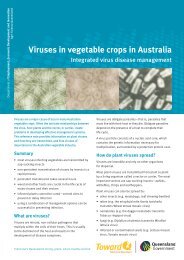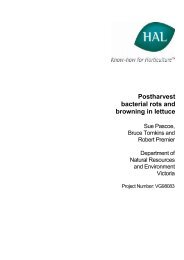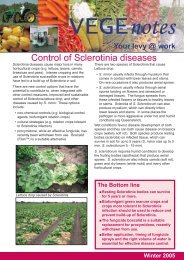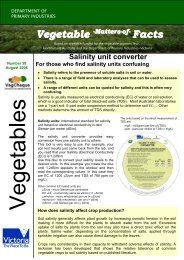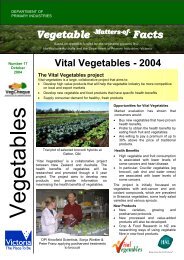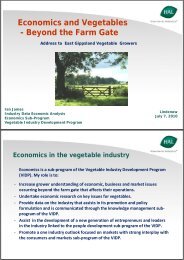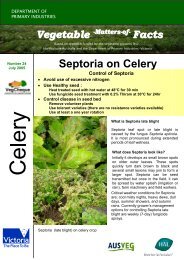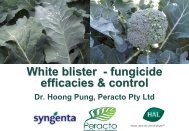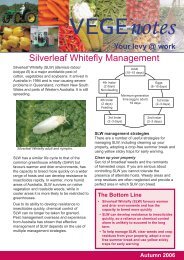Developing strategies to stimulate local consumption, export and ...
Developing strategies to stimulate local consumption, export and ...
Developing strategies to stimulate local consumption, export and ...
Create successful ePaper yourself
Turn your PDF publications into a flip-book with our unique Google optimized e-Paper software.
Dr.S.C.Tan <strong>and</strong> Mr H.Hoffmann in Western Australia are also looking in<strong>to</strong> suitable U.S.cultivars for that state (Horticulture Australia Limited, project No.VG97042). In Italyresearchers have found remarkable differences in the biochemical constituents betweendifferent cultivars (Venere et al., 2000). According <strong>to</strong> this research this variability could be auseful indica<strong>to</strong>r of the suitability of various cultivars <strong>to</strong> specific uses (eg. fresh, frozen,preserved in oil etc.). Unlike in overseas countries where a broad gene pool of cultivarsexists, in Australia there is a serious shortage of reliable cultivar material. Some of thepopular cultivars currently used by many growers, such as Green Globe <strong>and</strong> Purple Globe areof unknown origin. The majority of growers appreciate the practicality of using seededcultivars that are currently available. However, few are currently experimenting with suchcultivars <strong>to</strong> test their general performance <strong>and</strong> reliability.Various recent publications refer <strong>to</strong> Australian artichoke production as being steady at 500<strong>to</strong>nnes. However, based on the information gathered in our investigation, the artichokeproduction figure is more like 1300 <strong>to</strong>nnes (see section 5.1.2). Despite this small productioncompared <strong>to</strong> some overseas producers (Table 1), Australia manages <strong>to</strong> <strong>export</strong> small volumesof fresh artichokes in an ad-hoc fashion mainly <strong>to</strong> hospitality trades in the Asia/Pacific region.Trade figures, show that between 1994/95 <strong>and</strong> 1999/2000, the volume of globe artichokes(fresh or chilled) <strong>export</strong>s ranged from a low of 2.5 <strong>to</strong>nnes ($A5580 per <strong>to</strong>nne f.o.b.) in1995/96 <strong>to</strong> a high of 80 <strong>to</strong>nnes ($A3342 per <strong>to</strong>nne f.o.b.) in 1999/2000 (Anon., 2001a).Statistical Information Service). The statistics also show that Australia's four major <strong>export</strong>smarkets in 1999 were Taiwan, New Caledonia, Singapore <strong>and</strong> Brunei. Other markets include;Japan, Singapore, China {Hong Kong), Korea, Malaysia <strong>and</strong> Germany.3.5 Uses <strong>and</strong> health benefitsVarious parts of the globe artichoke can be used in different ways <strong>and</strong> for different purposes.The principal edible portion of the immature flower bud we call the artichoke's heart iscomposed of the fleshy bracts <strong>and</strong> the receptacle <strong>to</strong> which the bracts are attached. This part isconsumed in a number of ways, such as steamed, boiled, stuffed <strong>and</strong> then baked, marinated<strong>and</strong> battered <strong>and</strong> then fried etc. Another part is the artichoke stalk which when peeledexposes its core, another edible portion of the plant that has a similar texture <strong>and</strong> flavour <strong>to</strong>the heart. A favourite Italian way of eating artichoke is "in pinzimonio" which involvesdipping the fleshy parts of the bracts one by one in<strong>to</strong> a vinigraite dressing mixture as above<strong>and</strong> scrapping it off between the teeth. Besides fresh, various forms of processed artichokeare available on the markets such as preserved whole hearts in brine, frozen <strong>and</strong> antipas<strong>to</strong>(appetiser) products, purees (Plate 2).Globe artichoke is a versatile vegetable, renown for its nutritional value <strong>and</strong> excellent health^benefits because of its high fibre, vitamin <strong>and</strong> mineral content, especially iron (Appendix 1).This is in addition <strong>to</strong> its high content of phy<strong>to</strong>chemical or nutraceutical substances withmedicinal functions such as caffeoylquinic acid <strong>and</strong> cynarin. It is well documented thatextracts of globe artichoke leaves are known for their ability <strong>to</strong> de<strong>to</strong>xify the liver <strong>and</strong><strong>stimulate</strong> bile secretion (Wegener <strong>and</strong> Fintelmann, 1999) <strong>and</strong> <strong>to</strong> inhibit cholesterolbiosynthesis (Gebhardt, 1998). In Argentina, growers can generate additional income fromselling artichoke leaves (1.5-3.0 kg per plant at approximately $A1.00 per kg) <strong>to</strong> thepharmaceuticals industry (Garcia et al.2000). Cardinali et al., 2000 have shown that theleaves <strong>and</strong> external bud bracts (which are discarded as waste during processing) representabout 70% of the <strong>to</strong>tal biomass <strong>and</strong> could be utilised <strong>to</strong> extract important phy<strong>to</strong>chemicalcompounds. Almela et al., 2000 found that artichoke waste is a valuable material that couldbe used for animal fodder due <strong>to</strong> its Mgh <strong>to</strong>tal protein content, which is comparable with other10



